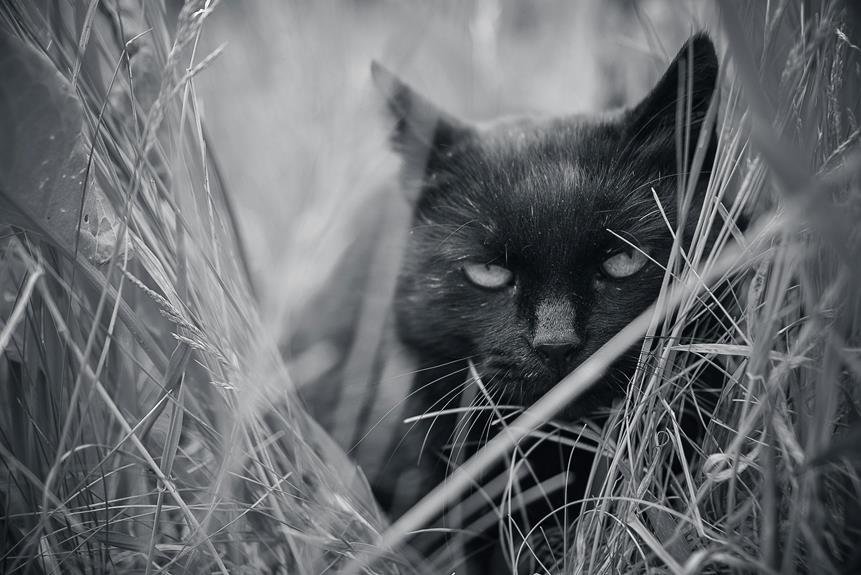
If your cat kneads you, it's because they are harkening back to their kitten days, seeking comfort, and showing they feel at home with you. This behavior helps them feel relaxed and content while marking you as theirs with their scent glands on their paws. If you want to understand more about this fascinating behavior, keep exploring the reasons behind your feline friend's kneading instincts.
The Origins of Kneading Behavior
When cats knead you, they're instinctively tapping into their ancestral behavior from nursing as kittens. This behavior dates back to when they were young, kneading their mother's belly to stimulate milk flow during nursing. Even as adult cats, this instinct remains strong. The rhythmic motion of kneading is a comforting and soothing action for cats, reminiscent of the security and nourishment they felt as kittens.
As your cat kneads you, they may also purr, indicating contentment and relaxation. This behavior is a sign of trust and affection towards you, as they view you as a source of comfort and safety. Cats often knead soft surfaces, such as blankets or your lap, to create a cozy spot for themselves. By kneading you, they're marking you with their scent, a way of claiming you as part of their territory.
Understanding the origins of kneading behavior can deepen your bond with your cat. Embrace this unique form of feline communication, recognizing it as a natural instinct that connects your cat to their kittenhood roots.
Instinctual Reasons for Kneading
Kneading is a natural instinct for cats, rooted in their early development and serving various purposes beyond simple comfort. This behavior traces back to kittenhood when they knead their mother's belly to stimulate milk flow during nursing. Even as adult cats, this instinct remains ingrained.
One reason for kneading is to mark territory – cats have scent glands on their paw pads, leaving their scent behind as they knead, claiming ownership. Another instinctual reason is to create a comfortable sleeping spot. By kneading a soft surface, cats can manipulate it to their liking before settling down.
Additionally, kneading helps cats stretch and flex their muscles, promoting circulation and maintaining their agility. This instinctual behavior is deeply rooted in feline nature, connecting them to their primal instincts and serving various functional purposes beyond mere cuddly companionship.
Emotional and Comfort Significance
To understand the emotional and comfort significance of your cat's kneading behavior, observe how they seek solace and security through this instinctual act. When your feline companion kneads you with their paws, it's a throwback to kittenhood when they'd knead their mother's belly to stimulate milk flow and create a cozy nest. This behavior is deeply ingrained in their instincts and can be a way for them to show contentment and relaxation in your presence.
Kneading is often accompanied by purring, another sign of your cat's comfort and happiness. The rhythmic motion of kneading can release endorphins, acting as a self-soothing mechanism for your cat during times of stress or anxiety. So, when your cat kneads you, they aren't only seeking physical comfort but also emotional reassurance. It's a way for them to bond with you and create a sense of security in your relationship. By understanding the emotional significance behind this behavior, you can strengthen the bond you share with your furry friend.
How to Respond to Kneading
Responding to your cat's kneading behavior can strengthen your bond and provide them with comfort and reassurance. When your cat starts kneading on you, it's essential to react appropriately.
Firstly, stay calm and allow your cat to continue this natural behavior. You can gently pet or stroke your cat while they knead to show them affection and encourage bonding. If the kneading becomes uncomfortable due to sharp claws, consider placing a soft blanket or towel on your lap for them to knead instead.
Offering a cozy and safe environment for your cat to knead will make them feel secure and content. Additionally, you can softly speak to your cat in a soothing tone while they knead, further reinforcing the positive experience.
Remember to observe your cat's body language during kneading; if they seem agitated or distressed, it might be best to give them some space. By responding thoughtfully to your cat's kneading, you can create a harmonious and loving relationship between you and your feline companion.
Conclusion
Next time your cat kneads you, remember it's a natural behavior rooted in their instincts and emotions.
By understanding the reasons behind kneading, you can better respond to your furry friend with love and care.
So, the next time your cat kneads you, enjoy the moment and appreciate the bond you share with your feline companion.




